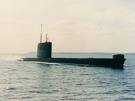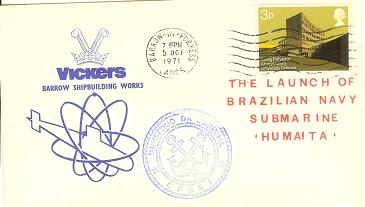|
British Royal Navy Oberon class
 Work on the first post war British production submarine design, the Porpoise class, began in 1949. Like all western design of the time it was heavily influenced by the German Type XXI. The requirements called for a speed of 17 knots to be sustained for 20 minutes, and for a maximum diving depth of 650 feet. The new submarines were design for ASW patrol mission. The Porpoise design proved particularly successful, and was succeeded a modified design, the Oberon, which although virtually indistinguishable externally (displacement and dimensions), incorporated a number of detail improvements-improved detection systems and the ability to fire homing torpedoes. Work on the first post war British production submarine design, the Porpoise class, began in 1949. Like all western design of the time it was heavily influenced by the German Type XXI. The requirements called for a speed of 17 knots to be sustained for 20 minutes, and for a maximum diving depth of 650 feet. The new submarines were design for ASW patrol mission. The Porpoise design proved particularly successful, and was succeeded a modified design, the Oberon, which although virtually indistinguishable externally (displacement and dimensions), incorporated a number of detail improvements-improved detection systems and the ability to fire homing torpedoes.
The Oberon has the conventional double-hull configuration of prewar British submarines. The long single cylinder pressure hull allows for a single deck layout with the control room positioned centrally.
Specifications, Oberon class:
The Oberon class is a relatively conventional post World War II design, base on a double hull configuration, single cylinder pressure hull and a single deck layout.
Displacement (srf/sub tons): 2,080/2,450
Dimensions (L*B*D feet): 295`3*26`6*18`1
Propulsion: diesel-electric, 2*1,850hp ASR 16 VVS-AS21 diesels-generators, 2*3,000hp English Electric electric motors, 2*244 Guppy type battery cells,2 shafts
Speed (srf/sub knots): 12/17
Range (srf/sub n/miles@knots): 9,000@12/unknown
Diving depth (feet): 450
Complement: 7 officers 57 enlisted
Missile: none
Torpedo: 6*21" (533 mm) bow torpedo tubes, 2*21" (533 mm) stern (short) torpedo tubes, total of 30 torpedoes
Mines: none
Armament: none
Construction
Thirteen submarines of the Oberon class were completed for the Royal Navy between 1959-65. During modernization programs the aft torpedo tubes were replaced with SUBTASS drum for passive array and a distinctive, bulbous, forward sonar dome was incorporated housing Triton 2051 instead of the 2007.
Having acquired reputation for reliability and quietness some 14 Oberons have been sold to foreign countries since 1962, they were regarded as best conventional submarines at the time.
Built by different British shipyards: three for Canada completed 1965-68, six for Australia 1967-78, three completed for Brazil 1973-77 and two for Chile 1976.
Back to History Index
 |
Brazil |
9999 |
The launch of Brazilian submarine Humaita (S-20, SSK, British Oberon class), 5 October 1971, Barroe In Furness, Lancs |
 |
Brazil |
9999 |
Keel laying of Brazilian submarine Humaita (S-20, SSK, British Oberon class), 3 November 1970, Barroe In Furness, Lancs |
|